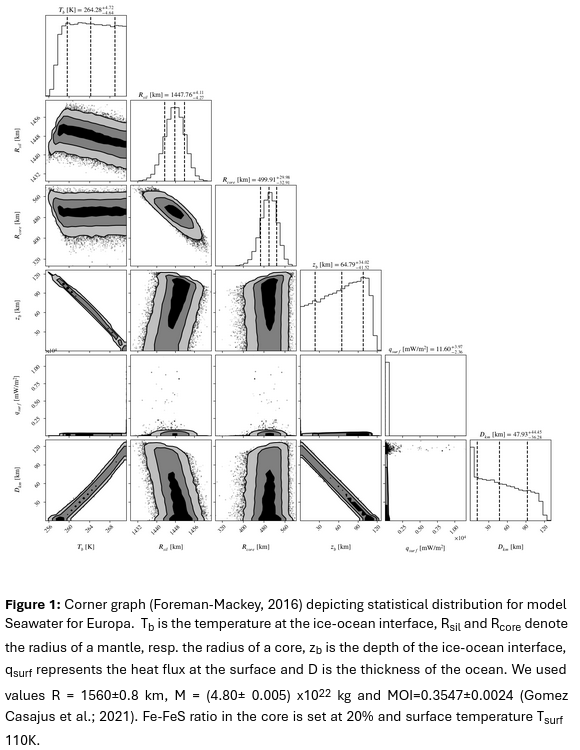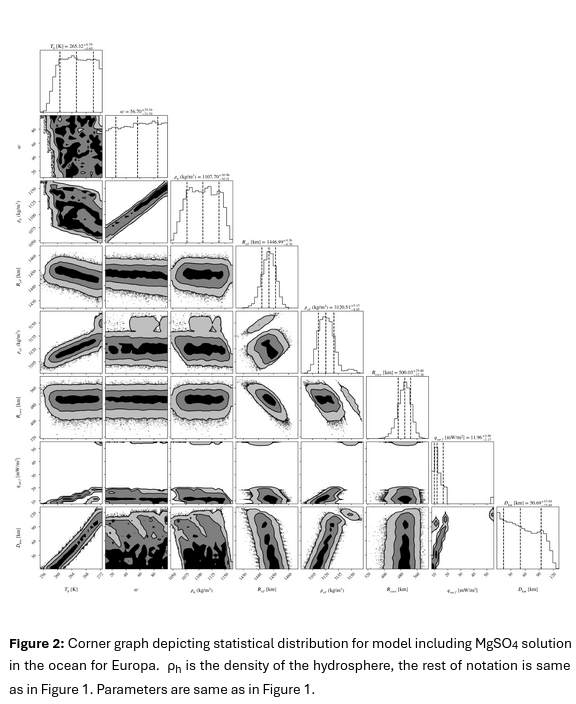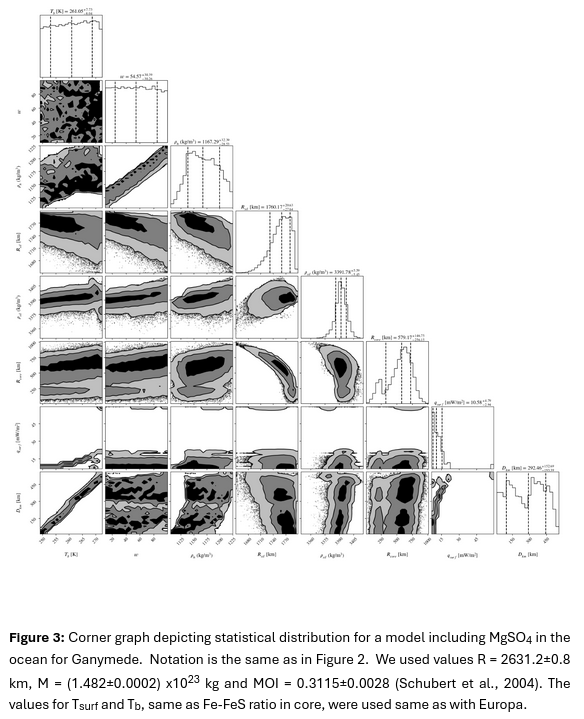Exploring Europa and Ganymede's Internal Structure: A Statistical Perspective
- Charles University, Faculty of Mathematics and Physics, Department of Geophysics, Prague, Czech Republic (terka.kosikova@gmail.com)
Introduction
Past missions, such as Galileo, Cassini and Juno, have significantly advanced our understanding of icy moons. Through their measurements, these missions unveiled the presence of subsurface water reservoirs. Building on these discoveries, upcoming missions, JUICE and Europa Clipper, hold the potential to further enhance our understanding of the hydrospheres by delivering new and improved data, including tidal deformation measurements (Cappuccio et al., 2020; Cappuccio et al., 2022; Mazarico et al., 2023).
Our study aims to characterize the hydrospheres of Europa and Ganymede. Europa, a smaller satellite, possesses a less extensive hydrosphere, where internal pressures are not expected to reach the levels required for the formation of high-pressure ice phases. In contrast, Ganymede, a larger and differentiated satellite, is known to harbour high-pressure ice phases within its hydrosphere. To evaluate these differences, we employed a combination of known thermodynamic properties (Choukroun and Grasset, 2010; Mcdougall and Barker., 2011; Journaux et al., 2020) alongside satellites’ parameters to assess their plausible internal structures. Additionally, we include anticipated Love number measurements from upcoming missions such as JUICE and Europa Clipper into our statistical analysis, aiming to enhance our understanding of the moons' structural characteristics.
Model
We employed the PlanetProfile (Styczinski et al., 2023; Vance et al., 2018) to analyse the internal structure, evaluating 1D models of structure based on fundamental planetary properties such as mass (M), moment of inertia (MOI), and radius (R).
Additionally, we coupled the PlanetProfile with the Markov chain Monte Carlo (MCMC, Foreman-Mackey et al., 2013) method to assess the statistical properties of the interior structure. Furthermore, to obtain Love numbers, necessary for determining tidal deformation, we will use own library, based on Sabadini and Vermeersen (2004).
Results
Europa
We assume that Europa is fully differentiated into the hydrosphere, mantle, and core to assess the structure. We analyzed the internal structure of two different oceanic compositions: Seawater and a solution containing MgSO4 salt. For Seawater, our statistical analysis includes variables such as M, R, and MOI assuming normal distribution and the temperature at the interface Ih-ocean interface, Tb, between 249K and 272.5K, assuming uniform distribution. For MgSO4 solution, salinity was incorporated as an additional variable, constrained within the range of 1-10 wt%, assuming uniform distribution.
The results for Seawater is depicted in Figure 1. For MgSO4 solution, findings are presented in Figure 2. As expected, our observations confirm the composition of Europa's hydrosphere consists of Ih ice and ocean. In the case of Seawater, despite assuming a uniform distribution of Tb, the actual distribution appears to be non-uniform, likely due to the absence of a corresponding model for the given parameters (R, M, MOI, Tb). However, Figure 2 illustrates that the introduction of salinity allows for lower values of Tb.
Ganymede
To model internal structure of Ganymede, we used same procedure as in the case of Europe. We also assumed that Ganymede is fully differentiated. However, the hydrosphere is further divided into layers of Ih ice, liquid ocean and layers of high-pressure ice phases.
In the case of Ganymede, we only worked with the composition of the MgSO4 salt ocean, whose salinity ranged within the same values as in the case of Europa. The results for Ganymede with MgSO4 solution are presented in Figure 3. By comparing with Figure 2, we observe a greater thickness of the ocean, as was expected.
Summary
We modelled the internal structure of the icy moons Europa and Ganymede, for the cases of Seawater composition for Europa, and MgSO4 solution for both Europa and Ganymede. The PlanetProfile was used and modified by implementing Markov chains, using Emcee library. Europa's hydrosphere is composed of a layer of Ih ice and ocean, and the hydrosphere of Ganymede is composed of layers of Ih ice, ocean, and high-pressure phases of ice, which agrees with theoretical assumptions. Furthermore, we integrate anticipated Love number measurements to reduce the uncertainty in the determination of the internal structure.
Acknowledgement
This study received funding from project SVV 260709.
References
Cappuccio et al. (2020). Ganymede's gravity, tides and rotational state from JUICE's 3 GM experiment simulation. Planetary and Space Science. 187. 104902. 10.1016/j.pss.2020.104902.
Cappuccio et al. (2022). Callisto and Europa Gravity Measurements from JUICE 3GM Experiment Simulation. Planet. Sci. J. 3 199. 10.3847/PSJ/ac83c4
Choukroun, Grasset. (2010). Thermodynamic data and modeling of the water and ammonia-water phase diagrams up to 2.2 GPa for planetary geophysics. The Journal of chemical physics. 133. 144502. 10.1063/1.3487520.
Foreman-Mackey et al. (2013) emcee: The MCMC Hammer, Publications of the Astronomical Society of the Pacific 125(925), p. 306. https://doi.org/10.1086/670067
Foreman-Mackey (2016). corner.py: Scatterplot matrices in Python. The Journal of Open Source Software, 1(2), 24. doi: 10.21105/joss.00024
Gomez Casajus et al. (2021). Updated Europa gravity field and interior structure from a reanalysis of Galileo tracking data. Icarus 358, 114187. https://doi.org/10.1016/j.icarus.2020.114187.
Journaux et al. (2020). Holistic approach for studying planetary hydrospheres: Gibbs representation of ices thermodynamics, elasticity, and the water phase diagram to 2,300 MPa. Journal of Geophysical Research: Planets, 125, e2019JE006176. https://doi.org/10.1029/2019JE006176
Mazarico et al. The Europa Clipper Gravity and Radio Science Investigation. Space Sci Rev 219, 30 (2023). https://doi.org/10.1007/s11214-023-00972-0
McDougall and Barker (2011). Getting started with TEOS-10 and the Gibbs seawater (GSW) oceanographic toolbox. SCOR/IAPSO WG, 127, 1–28.
Sabadini and Vermeersen (2004). Global Dynamics of the Earth: Applications of Normal Mode Relaxation Theory to Solid-Earth Geophysics. Kluwer Academic Publishers.
Schubert et al., Interior composition, structure and dynamics of the Galilean satellites, in Jupiter. The Planet, Satellites and Magnetosphere, vol. 1, 2004, pp. 281–306.
Styczinski et al. (2023). PlanetProfile: Self-consistent interior structure modeling for ocean worlds and rocky dwarf planets in Python. Earth and Space Science, 10, e2022EA002748. https://doi.org/10.1029/2022EA002748
Vance et al. (2018). Geophysical investigations of habitability in ice-covered ocean worlds. Journal of Geophysical Research: Planets Planets, 123, 180–205. https://doi.org/10.1002/2017JE005341



How to cite: Košíková, T. and Běhounková, M.: Exploring Europa and Ganymede's Internal Structure: A Statistical Perspective , Europlanet Science Congress 2024, Berlin, Germany, 8–13 Sep 2024, EPSC2024-323, https://doi.org/10.5194/epsc2024-323, 2024.